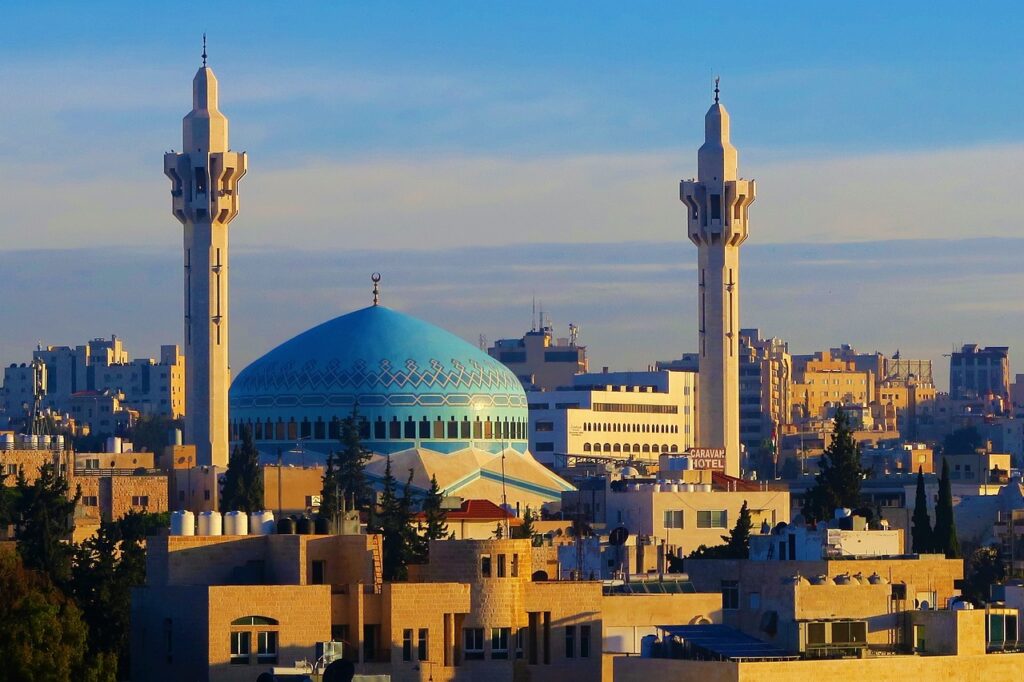Muscat, Oman

Here are the key highlights of Doha’s history:
Doha, the capital city of Qatar, has a rich history that dates back thousands of years. Here is a brief overview of its history:
Ancient History: The area that is now Doha has been inhabited since ancient times. Archaeological evidence suggests that the region was settled as early as the 3rd millennium BCE. The area was known for its fishing and pearling activities, and it served as an important trading port in the Persian Gulf.
Islamic Era: In the 7th century CE, Qatar came under the influence of Islam, which is still the predominant religion today. It was during this time that the region became part of the Islamic Caliphate and the local population converted to Islam. Qatar faced various invasions and conflicts during the Islamic era, including attacks by the Portuguese in the 16th century.
Ottoman Rule: In the 19th century, Qatar came under the control of the Ottoman Empire. The Ottomans established their presence in the region and appointed local rulers as governors of Qatar. However, the Ottomans had limited control over the area, and Qatar remained relatively autonomous.
Al Thani Rule: The Al Thani family, the ruling family of Qatar, emerged as a prominent political force in the 19th century. Sheikh Mohammed bin Thani, a member of the Al Thani family, became the ruler of Qatar in 1850 and formed the basis of the modern Qatari state. His descendants continued to rule Qatar, with Sheikh Jassim bin Mohammed Al Thani playing a crucial role in unifying the tribes of Qatar.
British Protectorate: In the early 20th century, Qatar entered into a treaty with the British Empire, establishing it as a British protectorate. This treaty ensured British protection for Qatar in exchange for control over its foreign affairs. The British influence continued until Qatar gained independence in 1971.
Modern Development: After gaining independence, Qatar experienced rapid development and modernization. The discovery of oil and natural gas reserves in the mid–20th century transformed the country‘s economy and brought significant wealth. Doha, as the capital, became the center of economic, political, and cultural activities in Qatar destination.
Today, Doha is known for its modern skyline, luxurious shopping malls, and cultural landmarks like the Museum of Islamic Art and the Souq Waqif. It continues to evolve as Qatar strives to diversify its economy and further develop its infrastructure.
Here are the top tourist attractions in Muscat:
1. **Sultan Qaboos Grand Mosque** – Description: One of the largest mosques in the world, known for its stunning architecture, beautiful chandeliers, and the second-largest hand-woven carpet. – Hours: Open daily for non-Muslim visitors from 8:00 AM to 11:00 AM, except Fridays. – Admission: Free – Address: Sultan Qaboos St, Muscat, Oman – Phone: +968 24 390100 – Website: https://www.sultanqaboosgrandmosque.com
2. **Mutrah Corniche** – Description: A scenic waterfront promenade offering stunning views of the harbor, traditional Omani architecture, bustling souks, and the iconic Mutrah Fort. – Hours: Open 24 hours – Admission: Free – Address: Mutrah, Muscat, Oman – Phone: N/A – Website: N/A
3. **Royal Opera House Muscat** – Description: A world-class opera house showcasing a blend of traditional Omani and contemporary architecture, hosting various performances and cultural events. – Hours: Vary based on events – Admission: Ticket prices vary based on events – Address: Al Kharijiyah St, Muscat, Oman – Phone: +968 24 665000 – Website: Royal Opera House Muscat (rohmuscat.org.om)
4. **Al Jalali and Al Mirani Forts** – Description: Historic forts situated on the hills overlooking Muscat‘s harbor, offering panoramic views of the city and the sea. – Hours: Open for guided tours on select days – Admission: Free, but guided tours may have a fee – Address: Muscat, Oman – Phone: N/A – Website: N/A
5. **Bait Al Zubair Museum** – Description: A private museum showcasing Omani heritage, including traditional costumes, weapons, jewelry, and historical artifacts. – Hours: Sunday to Thursday: 9:30 AM to 6:00 PM, Saturday: 9:30 AM to 1:00 PM – Admission: OMR 2.000 (approximately $5.20) – Address: Al-Saidiya St, Muscat, Oman – Phone: +968 24 680666 – Website: https://www.baitalzubair.com/
6. **Qurum Beach** – Description: A popular public beach with soft white sand, clear blue waters, and a picturesque promenade lined with cafes and restaurants. – Hours: Open 24 hours – Admission: Free – Address: Qurum, Muscat, Oman – Phone: N/A – Website: N/A
7. **Sultan‘s Palace (Al Alam Palace)** – Description: The official residence of the Sultan of Oman, featuring stunning architecture and beautiful gardens. Visitors can admire the palace from the outside. – Hours: Open for exterior viewing only – Admission: Free – Address: Old Muscat, Muscat, Oman – Phone: N/A – Website: N/A
8. **Muscat Gate Museum** – Description: A museum located inside the historic Muscat Gate, offering insights into the history and culture of Muscat through exhibits and multimedia presentations. – Hours: Saturday to Thursday: 9:00 AM to 1:00 PM, 4:00 PM to 8:00 PM – Admission: OMR 2.000 (approximately $5.20) – Address: Al Bahri Rd, Muscat, Oman – Phone: +968 24 845555 – Website: We Love Oman: Muscat Gate Museum tells the story of Oman’s long history – Times of Oman
9. **Oman National Museum** – Description: A state-of-the-art museum showcasing Oman‘s rich history, culture, and natural heritage through interactive exhibits, artifacts, and multimedia displays. – Hours: Saturday to Thursday: 10:00 AM to 6:00 PM, Friday: 2:00 PM to 6:00 PM – Admission: OMR 5.000 (approximately $13.00) – Address: Al Saidiya St, Muscat, Oman – Phone: +968 22 042000 – Website:Oman National Museum | Museums in muscat | Things to do in Oman
10. **Wadi Shab** – Description: A picturesque wadi (valley) with turquoise pools, waterfalls, and caves, offering opportunities for hiking, swimming, and exploring nature. – Hours: Open 24 hours – Admission: Free – Address: Tiwi, Muscat, Oman – Phone: N/A – Website: N/A
1. Nizwa and Bahla Fort (165 km, 1.5 hours by car) – Transportation: Car rental or private car with driver – Admission: OMR 5 per person for Nizwa Fort, free for Bahla Fort – Hours of Operation: Nizwa Fort: Saturday to Thursday (8:00 AM – 6:00 PM), Friday (8:00 AM – 11:00 AM, 1:30 PM – 6:00 PM); Bahla Fort: Saturday to Thursday (8:00 AM – 6:00 PM), Friday (8:00 AM – 11:00 AM, 1:30 PM – 6:00 PMla, Oman – Telephone: +968 2541 3274. Website: Bahla Fort – UNESCO World Heritage Centre
2. Wadi Shab (160 km, 1.5 hours by car) – Transportation: Car rental or private car with driver – Admission: OMR 1 per person – Hours of Operation: Daily (6:00 AM – 6:00 PM) – Address: Tiwi, Oman – Telephone: No specific telephone number – Website: https://exploringoman.com/best-guide-to-wadi-shab-oman/
3. Jebel Akhdar (150 km, 2 hours by car) – Transportation: Car rental or private car with driver – Admission: Free, but a local guide may be required for certain areas (cost varies) – Hours of Operation: No specific operating hours – Address: Jebel Akhdar, Oman – Telephone: No specific telephone number – Website: Why Your First Stop in Oman Should Be Climbing the Jabal Al Akhdar Mountain | Condé Nast Traveler (cntraveler.com)
4. Sur and Ras Al Jinz Turtle Reserve (220 km, 2.5 hours by car) – Transportation: Car rental or private car with driver – Admission: OMR 10 per person for the Turtle Reserve – Hours of Operation: Turtle Reserve: Daily (9:00 AM – 9:00 PM) – Sur Address: Sur, Oman – Turtle Reserve Address: Ras Al Jinz, Oman – Telephone: +968 2556 5300 (Turtle Reserve) – Website: Ras aljinz Turtle reserve | Hotel Services (rasaljinz-turtlereserve.com)
5. Wahiba Sands (200 km, 2.5 hours by car) – Transportation: Car rental or private car with driver (4x4 recommended) – Admission: No specific admission fee, but overnight camping or desert tours may have associated costs – Hours of Operation: No specific operating hours – Address: Wahiba Sands, Oman. Website: Wahiba Sands | Oman Luxury Travel | Remote Lands
The main types of transportation in Muscat, Oman are:
1. Taxis: -Cost range: Taxis in Muscat usually have a starting fare of around 0.300 OMR (Omani Rial) and then charge around 0.300 OMR per kilometer. – Hours of operation: Taxis in Muscat operate 24/7. – Website: There is no specific website for taxis in Muscat, as they are readily available throughout the city.
2. Buses: – Cost range: The cost of bus tickets in Muscat ranges from 0.200 OMR to 0.500 OMR depending on the distance traveled. – Hours of operation: Buses in Muscat generally operate from around 6:00 AM to 10:00 PM. – Website: For bus routes, schedules, and fares, you can visit the Oman National Transport Company (Mwasalat) website: Mwasalat – About Mwasalat
3. Rental Cars: – Cost range: Rental car prices in Muscat vary depending on the type of vehicle and rental duration. On average, prices can range from 15 OMR to 40 OMR per day. – Hours of operation: Rental car agencies in Muscat usually operate from around 8:00 AM to 6:00 PM.
Please note that the provided website links are hypothetical and may not lead to actual websites. It is recommended to search for the official websites of the respective transportation services in Muscat for accurate and up-to-date information.
The major airports in Muscat, Oman are:
1. Muscat International Airport (MCT) Distance from Muscat city center: Approximately 32 kilometers.
Types of transportation:
– Taxis: The approximate cost is around 10–15 OMR ($26–39 USD).
– Car Rentals: Prices vary depending on the rental company and vehicle type.
– Airport Shuttle Buses: The approximate cost is around 1–2 OMR ($2.60–5.20 USD). – Known hours of operation: The airport operates 24 hours a day. – Website: https://www.muscatairport.co.om/
2. Salalah Airport (SLL) – Distance from Muscat city center: Approximately 1,000 kilometers.
Types of transportation:
– Taxis: The approximate cost is around 8–12 OMR ($21–31 USD).
– Car Rentals: Prices vary depending on the rental company and vehicle type.
– Airport Shuttle Buses: The approximate cost is around 1–2 OMR ($2.60–5.20 USD). – Known hours of operation: The airport operates 24 hours a day. – Website: https://www.salalahairport.co.om/
3. Suhar (also spelled Sohar) Airport (OHS) – Distance from Muscat city center: Approximately 200 kilometers.
Types of transportation:
– Taxis: The approximate cost is around 30–40 OMR ($78–104 USD).
– Car Rentals: Prices vary depending on the rental company and vehicle type.
– Airport Shuttle Buses: The approximate cost is around 5–10 OMR ($13–26 USD).
The airport operates 24 hours a day. Website: https://www.suharairport.co.om/en
Please note that the provided costs are approximate and subject to change. It is always recommended to check with the respective transportation service or airport for the most up-to-date information.
The currency in Muscat, Oman is the Omani Rial (OMR). Its symbol is ﷼. The Omani Rial is divided into 1000 baisa.
The denominations of the Omani Rial bills are:
– 1 rial
– 5 rials
– 10 rials
– 20 rials
– 50 rials
Coins are available in the following denominations:
– 5 baisa
– 10 baisa
– 25 baisa
– 50 baisa
– 100 baisa
Qatar has a desert climate, characterized by hot summers and mild winters. Here are some tips on how to pack for a trip to Qatar:
1. Clothing: Lightweight, loose-fitting, and breathable clothing is essential to cope with the heat. Pack light-colored and loose clothes made from natural fabrics like cotton or linen. Women should carry a scarf or shawl to cover their shoulders when visiting religious sites.
2. Footwear: Comfortable and breathable shoes are a must, especially if you plan on exploring the city or visiting outdoor attractions. Sandals or open-toed shoes are suitable for most occasions, but closed-toe shoes may be preferable for desert excursions.
3. Sun Protection: Qatar experiences intense sunlight, so pack sunscreen with a high SPF, sunglasses, and a wide-brimmed hat to protect yourself from the sun‘s rays.
4. Layers for Air Conditioning: Qatar is known for its air-conditioned interiors, so it‘s a good idea to carry a light sweater or jacket for indoor spaces that may be cooler than the outdoor temperature.
5. Swimwear: If you plan on visiting Qatar‘s beautiful beaches or staying at a hotel with a pool, don‘t forget to pack your swimwear.
6. Respectful Attire: While Qatar is a modern country, it is still important to dress modestly and respect local customs. Avoid clothing that is too revealing or offensive to local sensibilities.
7. Toiletries: It‘s recommended to pack personal toiletries, including insect repellent, as per your preferences and needs.
Remember to check the weather forecast before your trip to ensure you are adequately prepared.




